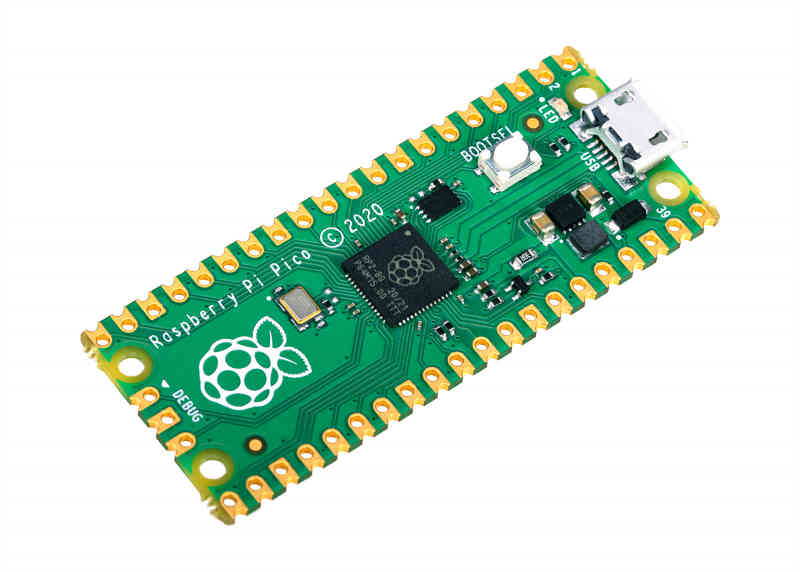| The New Raspberry Pi Pico Breaks The Mold |
| Written by Harry Fairhead | |||
| Thursday, 21 January 2021 | |||
|
The Raspberry Pi Pico is a daring venture for the Raspberry Pi Foundation in more ways than one. What exactly is it all about? The announcement of an addition to the Raspberry Pi range is usually a big thing, but this one, the Pico, is small - very small.
It's 21mm x 51mm - about the size of a old LSI chip if you can remember those - and it's very cheap at $4. No, it isn't a replacement for the Pi Zero as it is a small micro-controller and doesn't run Linux or have any WiFi/Bluetooth. This is more the sort of thing you might use in place of an Arduino. So is this competition for the Arduino? It has to be, but Arduino has produced a version of the Nano based on the same hardware so it doesn't seem to see it like that. Various other companies have also used the same chip to create their own versions of the Pico. The second important factor is that that the Pico is based on a custom chip designed by the Raspberry Pi Foundation. This means that it no longer has to depend on Broadcom for this particular product. At the moment the Pico is available and customers are limited in the number that they can buy, but unlike the Pi Zero it does look like a temporary restriction. It seems that this one is intended for industrial use as well as the home/educational market. The processor is based on an Arm Cortex M0+ processor with two cores running at 133MHz. Where it differs from other Cortex M0s is in its peripherals. The full spec is:
There is no floating point hardware support but there are floating point libraries. From a computational point of view, this isn't a powerful device, but that might not matter. It has a good selection of GPIO pins for SPI, I2C and PWM but the interesting factor is the 8 programmable state machines. If you are prepared to dive into the details you can program a GPIO pin to respond to inputs in a custom way so, say, decoding a protocol without the need to involve the CPU. I can already think of uses for this. It also has a low-power mode that makes it suitable for battery operation. There is also an on-chip clock, temperature sensor and a single LED that you can use to implement your first Blinky program. Programming is officially via either MicroPython or C. There is a C library that you can use to create programs and, to run them, all you have to do is connect the Pico via USB and drag-and-drop the executable onto the USB drive that is set up.
So much for the details - what about the context? The Pico is being introduced as if it was another Pi - but it isn't. It has very little, if anything, in common with the other models. It doesn't use the same software, it doesn't run Linux and it doesn't have the same GPIO configuration. This is a new device that has nothing at all to do with previous Pis. As it's not a Linux device there is no commonality of software at all - this is a whole new ball game. You can't even factor in the idea that there is a existing community that will gather round and support it - this really isn't a Raspberry Pi, it's something new. Of course, there is a lot of love for all things Pi and it is possible that this love with extend to the Pico, but it isn't a forgone conclusion. Then there is the matter of why you would use it? It is similar to a micro:bit, but it has none of the extra features of the micro:bit - no accelerometer, no display and no Bluetooth. It seems the choice is between an Arduino Nano and the Raspberry Pi Pico. The Nano is more expensive, but also available with BlueTooth. The only things the Pico has going for it are the Raspberry Pi name and, of course, its very low cost. What stops it from having a wider appeal is lack of WiFi or BlueTooth. There is plenty of space on the PCB so it isn't impossible that this is the first of a line of Pico devices - watch this space.
More InformationMeet Raspberry Silicon: Raspberry Pi Pico now on sale at $4 Related ArticlesPi Compute Module 4 - Time to Take Industrial Pi Seriously Raspberry Pi 4 Sets New Performance High At Same Cost Raspberry Pi 3A+ Last Of The Line The Remarkable Rise of Raspberry Pi Pi Zero Wireless A $10 Birthday Present Raspberry Pi 3 Confirmed - 64-bit For $35
To be informed about new articles on I Programmer, sign up for our weekly newsletter, subscribe to the RSS feed and follow us on Twitter, Facebook or Linkedin.
Comments
or email your comment to: comments@i-programmer.info
|
|||
| Last Updated ( Thursday, 21 January 2021 ) |


